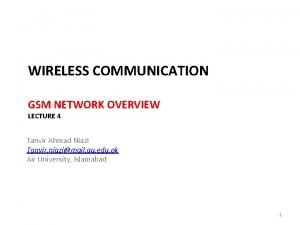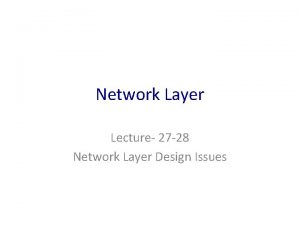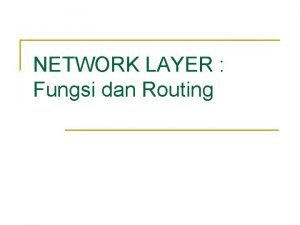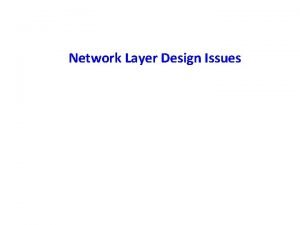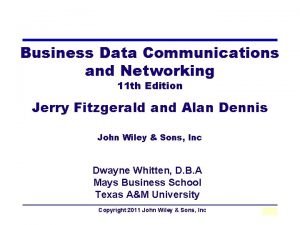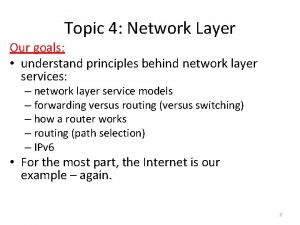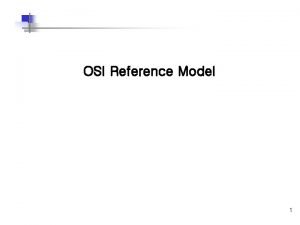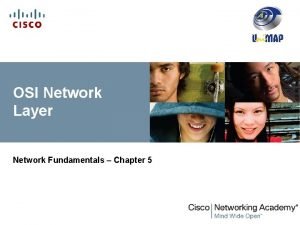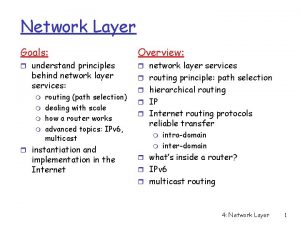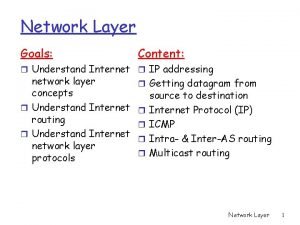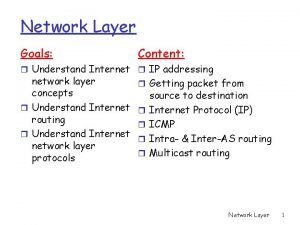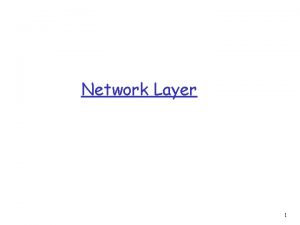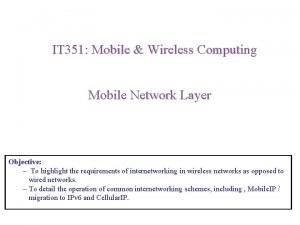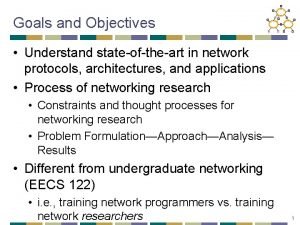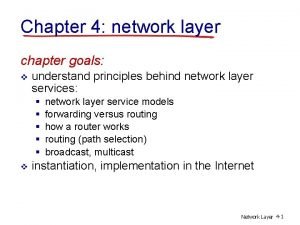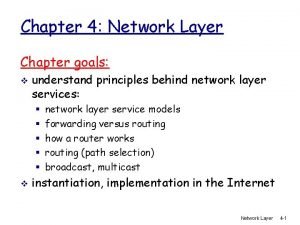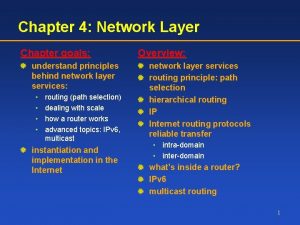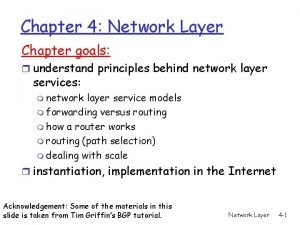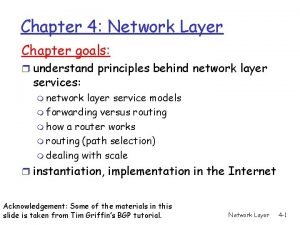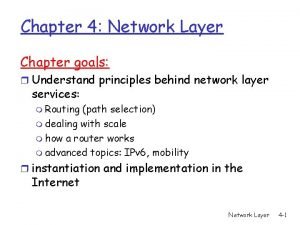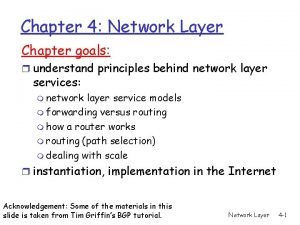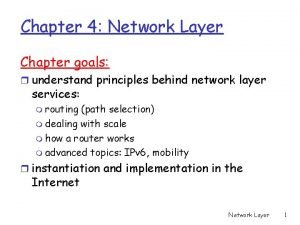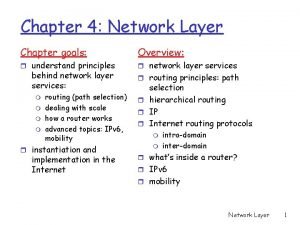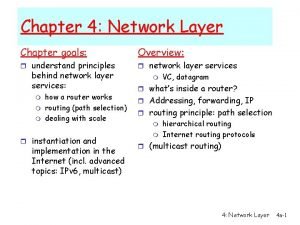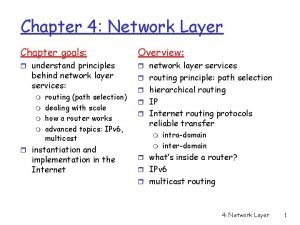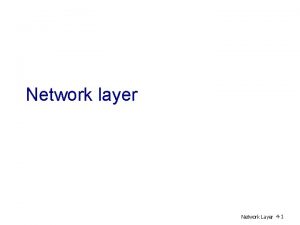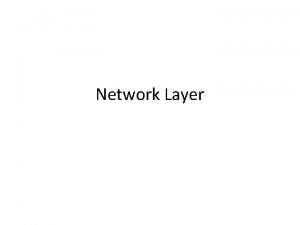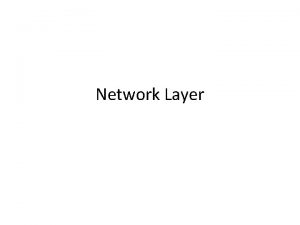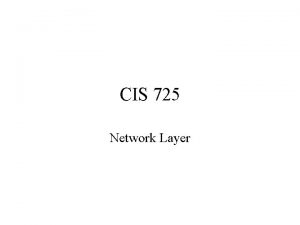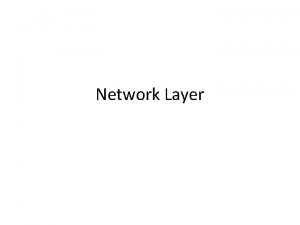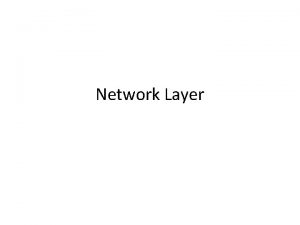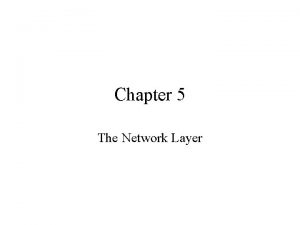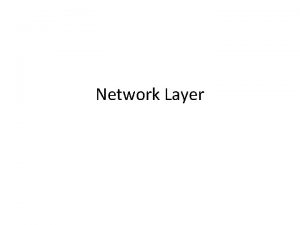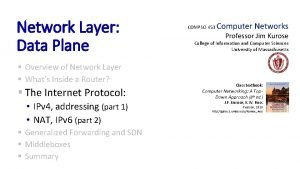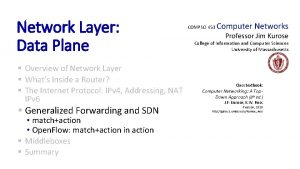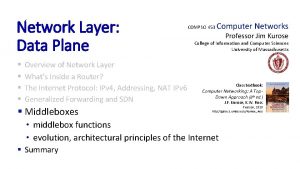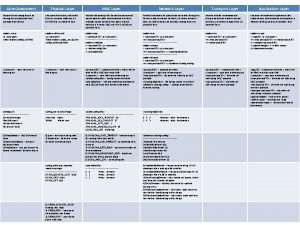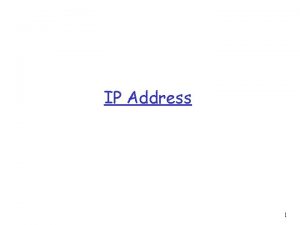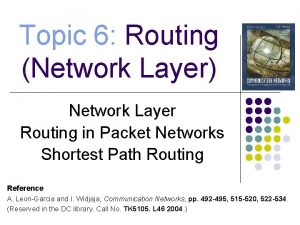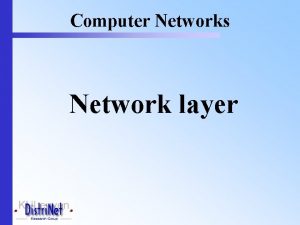Network Layer Overview and IP Network Layer 1





































- Slides: 37

Network Layer Overview and IP Network Layer 1

Network layer r transport segment from r r sending to receiving host on sending side encapsulates segments into datagrams on rcving side, delivers segments to transport layer network layer protocols in every host, router Router examines header fields in all IP datagrams passing through it application transport network data link physical network data link physical network data link physical application transport network data link physical Network Layer 2

Key Network-Layer Functions r forwarding: move packets from router’s input to appropriate router output r routing: determine route taken by packets from source to dest. m Routing algorithms Network Layer 3

Interplay between routing and forwarding routing algorithm local forwarding table header value output link 0100 0101 0111 1001 3 2 2 1 value in arriving packet’s header 0111 1 3 2 Network Layer 4

Network service model Example services for individual datagrams: r guaranteed delivery r Guaranteed delivery with less than 40 msec delay Example services for a flow of datagrams: r In-order datagram delivery r Guaranteed minimum bandwidth to flow r Restrictions on changes in inter-packet spacing Network Layer 5

Virtual circuits “source-to-dest path behaves much like telephone circuit” m m performance-wise network actions along source-to-dest path r call setup, teardown for each call before data can flow r each packet carries VC identifier (not destination host address) r every router on source-dest path maintains “state” for each passing connection r link, router resources (bandwidth, buffers) may be allocated to VC Network Layer 6

Datagram networks r no call setup at network layer r routers: no state about end-to-end connections m no network-level concept of “connection” r packets forwarded using destination host address m packets between same source-dest pair may take different paths r Why is this OK for the Internet? application transport network data link 1. Send data physical application transport 2. Receive data network data link physical Network Layer 7

Forwarding table Destination Address Range 4 billion possible entries Link Interface 11001000 00010111 00010000 through 11001000 00010111 1111 0 11001000 00010111 00011000 0000 through 11001000 00010111 00011000 1111 1 11001000 00010111 00011001 0000 through 11001000 00010111 00011111 2 otherwise 3 Network Layer 8

Longest prefix matching Prefix Match 11001000 00010111 00010 11001000 00010111 00011000 11001000 00010111 00011 otherwise Link Interface 0 1 2 3 Examples DA: 11001000 00010111 00010110 10100001 Which interface? DA: 11001000 00010111 00011000 1010 Which interface? Network Layer 9

Datagram or VC network: why? Internet r data exchange among ATM r evolved from telephony computers r human conversation: m “elastic” service, no strict m strict timing, reliability timing requirements r “smart” end systems m need for guaranteed (computers) service m can adapt, perform r “dumb” end systems control, error recovery m telephones m simple inside network, m complexity inside complexity at “edge” network r many link types m different characteristics m uniform service difficult Network Layer 10

The Internet Network layer Host, router network layer functions: Transport layer: TCP, UDP Network layer IP protocol • addressing conventions • datagram format • packet handling conventions Routing protocols • path selection • RIP, OSPF, BGP forwarding table ICMP protocol • error reporting • router “signaling” Link layer physical layer Network Layer 11

IP datagram format IP protocol version number header length (bytes) “type” of data max number remaining hops (decremented at each router) upper layer protocol to deliver payload to how much overhead with TCP? r 20 bytes of TCP r 20 bytes of IP r = 40 bytes + app layer overhead 32 bits ver head. type of len service length fragment 16 -bit identifier flgs offset upper time to Internet layer live checksum total datagram length (bytes) for fragmentation/ reassembly 32 bit source IP address 32 bit destination IP address Options (if any) data (variable length, typically a TCP or UDP segment) E. g. timestamp, record route taken, specify list of routers to visit. Network Layer 12

IP Fragmentation & Reassembly r network links have MTU (max. transfer size) - largest possible link-level frame. m different link types, different MTUs r large IP datagram divided (“fragmented”) within net m one datagram becomes several datagrams m “reassembled” only at final destination m IP header bits used to identify, order related fragments fragmentation: in: one large datagram out: 3 smaller datagrams reassembly Network Layer 13

IP Fragmentation and Reassembly Example r 4000 byte datagram r MTU = 1500 bytes 1480 bytes in data field offset = 1480/8 length ID fragflag offset =4000 =x =0 =0 One large datagram becomes several smaller datagrams length ID fragflag offset =1500 =x =1 =0 length ID fragflag offset =1500 =x =1 =185 length ID fragflag offset =1040 =x =0 =370 Network Layer 14

IP Addressing: introduction r IP address: 32 -bit identifier for host, router interface: connection between host/router and physical link m m m router’s typically have multiple interfaces host may have multiple interfaces IP addresses associated with each interface 223. 1. 1. 1 223. 1. 1. 2 223. 1. 1. 4 223. 1. 1. 3 223. 1. 2. 1 223. 1. 2. 9 223. 1. 3. 27 223. 1. 2. 2 223. 1. 1. 1 = 11011111 00000001 223 1 1 Network Layer 1 15

Subnets r IP address: m subnet part (high order bits) m host part (low order bits) r What’s a subnet ? m device interfaces with same subnet part of IP address m can physically reach other without intervening router 223. 1. 1. 1 223. 1. 1. 2 223. 1. 1. 4 223. 1. 1. 3 223. 1. 2. 1 223. 1. 2. 9 223. 1. 3. 27 223. 1. 2. 2 LAN 223. 1. 3. 2 network consisting of 3 subnets Network Layer 16

Subnets Recipe r To determine the subnets, detach each interface from its host or router, creating islands of isolated networks. Each isolated network is called a subnet. 223. 1. 1. 0/24 223. 1. 2. 0/24 223. 1. 3. 0/24 Subnet mask: /24 Network Layer 17

Subnets 223. 1. 1. 2 How many? 223. 1. 1. 1 223. 1. 1. 4 223. 1. 1. 3 223. 1. 9. 2 223. 1. 7. 0 223. 1. 9. 1 223. 1. 7. 1 223. 1. 8. 0 223. 1. 2. 6 223. 1. 2. 1 223. 1. 3. 27 223. 1. 2. 2 223. 1. 3. 2 Network Layer 18

Classful Addressing class A 0 network B 10 C 110 D 1110 1. 0. 0. 0 to 127. 255 host network 128. 0. 0. 0 to 191. 255 host network multicast address host 192. 0. 0. 0 to 223. 255 224. 0. 0. 0 to 239. 255 32 bits Network Layer 19

IP addressing: CIDR: Classless Inter. Domain Routing m subnet portion of address of arbitrary length m address format: a. b. c. d/x, where x is # bits in subnet portion of address subnet part host part 11001000 00010111 00010000 200. 23. 16. 0/23 Network Layer 20

IP addresses: how to get one? Q: How does host get IP address? r hard-coded by system admin in a file m /etc/hosts r DHCP: Dynamic Host Configuration Protocol: dynamically get address from as server m “plug-and-play” (more in next chapter) Network Layer 21

IP addresses: how to get one? Q: How does network get subnet part of IP addr? A: gets allocated portion of its provider ISP’s address space ISP's block 11001000 00010111 00010000 200. 23. 16. 0/20 Organization 1 Organization 2. . . 11001000 00010111 00010000 11001000 00010111 00010010 0000 11001000 00010111 00010100 0000 …. 200. 23. 16. 0/23 200. 23. 18. 0/23 200. 23. 20. 0/23 …. Organization 7 11001000 00010111 00011110 0000 200. 23. 30. 0/23 Network Layer 22

Hierarchical addressing: route aggregation Hierarchical addressing allows efficient advertisement of routing information: Organization 0 200. 23. 16. 0/23 Organization 1 200. 23. 18. 0/23 Organization 2 200. 23. 20. 0/23 Organization 7 . . . Fly-By-Night-ISP “Send me anything with addresses beginning 200. 23. 16. 0/20” Internet 200. 23. 30. 0/23 ISPs-R-Us “Send me anything with addresses beginning 199. 31. 0. 0/16” Network Layer 23

Hierarchical addressing: more specific routes ISPs-R-Us has a more specific route to Organization 1 Organization 0 200. 23. 16. 0/23 Organization 2 200. 23. 20. 0/23 Organization 7 . . . Fly-By-Night-ISP “Send me anything with addresses beginning 200. 23. 16. 0/20” Internet 200. 23. 30. 0/23 ISPs-R-Us Organization 1 200. 23. 18. 0/23 “Send me anything with addresses beginning 199. 31. 0. 0/16 or 200. 23. 18. 0/23” Longest prefix match! Network Layer 24

IP addressing: the last word. . . Q: How does an ISP get block of addresses? A: ICANN: Internet Corporation for Assigned Names and Numbers m allocates addresses m manages DNS m assigns domain names, resolves disputes Network Layer 25

NAT: Network Address Translation rest of Internet local network (e. g. , home network) 10. 0. 0/24 10. 0. 0. 1 10. 0. 0. 2 138. 76. 29. 7 10. 0. 0. 3 All datagrams leaving local network have same single source NAT IP address: 138. 76. 29. 7, different source port numbers Datagrams with source or destination in this network have 10. 0. 0/24 address for source, destination (as usual) Network Layer 26

NAT: Network Address Translation r Motivation: local network uses just one IP address as far as outside word is concerned: m no need to be allocated range of addresses from ISP: - just one IP address is used for all devices m can change addresses of devices in local network without notifying outside world m can change ISP without changing addresses of devices in local network m devices inside local net not explicitly addressable, visible by outside world (a security plus). Network Layer 27

NAT: Network Address Translation Implementation: NAT router must: m outgoing datagrams: replace (source IP address, port #) of every outgoing datagram to (NAT IP address, new port #). . . remote clients/servers will respond using (NAT IP address, new port #) as destination addr. m remember (in NAT translation table) every (source IP address, port #) to (NAT IP address, new port #) translation pair m incoming datagrams: replace (NAT IP address, new port #) in dest fields of every incoming datagram with corresponding (source IP address, port #) stored in NAT table Network Layer 28

NAT: Network Address Translation 2: NAT router changes datagram source addr from 10. 0. 0. 1, 3345 to 138. 76. 29. 7, 5001, updates table 2 NAT translation table WAN side addr LAN side addr 1: host 10. 0. 0. 1 sends datagram to 128. 119. 40, 80 138. 76. 29. 7, 5001 10. 0. 0. 1, 3345 …… …… S: 10. 0. 0. 1, 3345 D: 128. 119. 40. 186, 80 S: 138. 76. 29. 7, 5001 D: 128. 119. 40. 186, 80 138. 76. 29. 7 S: 128. 119. 40. 186, 80 D: 138. 76. 29. 7, 5001 3: Reply arrives dest. address: 138. 76. 29. 7, 5001 3 1 10. 0. 0. 4 S: 128. 119. 40. 186, 80 D: 10. 0. 0. 1, 3345 10. 0. 0. 2 4 10. 0. 0. 3 4: NAT router changes datagram dest addr from 138. 76. 29. 7, 5001 to 10. 0. 0. 1, 3345 Network Layer 29

NAT: Network Address Translation r 16 -bit port-number field: m 60, 000 simultaneous connections with a single LAN-side address! r NAT is controversial: m routers should only process up to layer 3 m violates end-to-end argument • NAT possibility must be taken into account by app designers, eg, P 2 P applications m address IPv 6 shortage should instead be solved by Network Layer 30

ICMP: Internet Control Message Protocol r used by hosts & routers to communicate network-level information m error reporting: unreachable host, network, port, protocol m echo request/reply (used by ping) r network-layer “above” IP: m ICMP msgs carried in IP datagrams r ICMP message: type, code plus first 8 bytes of IP datagram causing error Type 0 3 3 3 4 Code 0 0 1 2 3 6 7 0 8 9 10 11 12 0 0 0 description echo reply (ping) dest. network unreachable dest host unreachable dest protocol unreachable dest port unreachable dest network unknown dest host unknown source quench (congestion control - not used) echo request (ping) route advertisement router discovery TTL expired bad IP header Network Layer 31

Traceroute and ICMP r Source sends series of UDP segments to dest m m m First has TTL =1 Second has TTL=2, etc. Unlikely port number r When nth datagram arrives to nth router: m m m Router discards datagram And sends to source an ICMP message (type 11, code 0) Message includes name of router& IP address r When ICMP message arrives, source calculates RTT r Traceroute does this 3 times Stopping criterion r UDP segment eventually arrives at destination host r Destination returns ICMP “host unreachable” packet (type 3, code 3) r When source gets this ICMP, stops. Network Layer 32

IPv 6 r Initial motivation: 32 -bit address space soon to be completely allocated. r Additional motivation: m header format helps speed processing/forwarding m header changes to facilitate Qo. S IPv 6 datagram format: m fixed-length 40 byte header m no fragmentation allowed Network Layer 33

IPv 6 Header (Cont) Priority: identify priority among datagrams in flow Flow Label: identify datagrams in same “flow. ” (concept of“flow” not well defined). Next header: identify upper layer protocol for data Network Layer 34

Other Changes from IPv 4 r Checksum: removed entirely to reduce processing time at each hop r Options: allowed, but outside of header, indicated by “Next Header” field r ICMPv 6: new version of ICMP m additional message types, e. g. “Packet Too Big” m multicast group management functions Network Layer 35

Transition From IPv 4 To IPv 6 r Not all routers can be upgraded simultaneous m no “flag days” m How will the network operate with mixed IPv 4 and IPv 6 routers? r Dual-stack r Tunneling: IPv 6 carried as payload in IPv 4 datagram among IPv 4 routers Network Layer 36

Tunneling Logical view: Physical view: A B IPv 6 A B C IPv 6 IPv 4 Flow: X Src: A Dest: F data A-to-B: IPv 6 E F IPv 6 D E F IPv 4 IPv 6 tunnel Src: B Dest: E Flow: X Src: A Dest: F data B-to-C: IPv 6 inside IPv 4 Flow: X Src: A Dest: F data E-to-F: IPv 6 Network Layer 37
 Pigmented layer and neural layer
Pigmented layer and neural layer Brush border enzymes
Brush border enzymes Secure socket layer and transport layer security
Secure socket layer and transport layer security Secure socket layer and transport layer security
Secure socket layer and transport layer security Secure socket layer and transport layer security
Secure socket layer and transport layer security Secure socket layer and transport layer security
Secure socket layer and transport layer security Gsm network overview
Gsm network overview Presentation layer functions
Presentation layer functions Layer 2 e layer 3
Layer 2 e layer 3 Layer-by-layer assembly
Layer-by-layer assembly Layer 2 vs layer 3 bitstream
Layer 2 vs layer 3 bitstream Network layer design
Network layer design Network layer design issues in computer networks
Network layer design issues in computer networks Fungsi utama network layer
Fungsi utama network layer Network layer design issues
Network layer design issues Introduction to network layer
Introduction to network layer 5 layer network model
5 layer network model Two layer network
Two layer network Goals of network layer
Goals of network layer What is osi model explain?
What is osi model explain? Goals of network layer
Goals of network layer Goals of network layer
Goals of network layer Goals of network layer
Goals of network layer Goals of network layer
Goals of network layer Goals of network layer
Goals of network layer Mobile network layer
Mobile network layer Networking goals and objectives
Networking goals and objectives Goals of network layer
Goals of network layer Goals of network layer
Goals of network layer Goals of network layer
Goals of network layer Goals of network layer
Goals of network layer Goals of network layer
Goals of network layer Goals of network layer
Goals of network layer Goals of network layer
Goals of network layer Isps-r-us
Isps-r-us Goals of network layer
Goals of network layer Goals of network layer
Goals of network layer Goals of network layer
Goals of network layer






